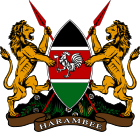
Back رؤية كينيا 2030 Arabic Kenya Vision 2030 French Kenya Vision 2030 Polish Ruwaza ya Kenya 2030 Swahili
This article appears to contain a large number of buzzwords. (March 2016) |
| Ruwaza ya Kenya 2030 | |
 The official logo of the project. | |
| Development programme overview | |
|---|---|
| Formed | 10 June 2008[1][2] |
| Type | Development blueprint |
| Jurisdiction | Government of Kenya |
| Motto | Towards a globally competitive and prosperous nation |
| Minister responsible | |
| Key document | |
| Website | www |
 |
|---|
|
|
Kenya Vision 2030 (Swahili: Ruwaza ya Kenya 2030) is a Kenyan development program, aiming to raise the average standard of living in Kenya to middle income by 2030. It was launched on 10 June 2008 by President Mwai Kibaki.[1][2][3] Developed through "an all-inclusive and participatory stakeholder consultative process, involving Kenyans from all parts of the country," the Vision is based on three "pillars": Economic, Social, and Political.[4] The Vision's adoption comes after the country's GDP growth went from 0.6% in 2002 to 6.1% in 2006,[5] under Kibaki's Economic Recovery Strategy for Wealth and Employment Creation (ERS).
The Kenya Vision 2030 is to be implemented in successive five-year plans, with the first such plan covering the period 2008–2012. Under the Vision, Kenya expected to meet its Millennium Development Goals (MDGs) by the deadline in 2015, although this has not been achieved.
The Vision 2030 development process was launched by President Mwai Kibaki on 30 October 2006 when he instructed the National Vision Steering Committee to produce a medium-term plan with full details on the development programmes that would be implemented in the first five years after the ERS expires on 31 December 2007. A consultative approach was undertaken through workshops with stakeholders from all levels of the public service, the private sector, civil society, the media and NGOs while in rural areas, provincial consultative forums were also held throughout the country.
The objective of all these consultations was to provide an in-depth understanding of the country's development problems and the necessary strategies to achieve the 2030 goals.
A similar process and methodology was followed in identifying projects and priorities in the social and political pillars. Detailed analysis was carried out under a consultative process in order to come up with strategies capable of resolving the social and political problems that Kenyans face today. To arrive at workable solutions, the team of experts learned as much as they could from countries that have achieved rapid growth and also improved the lives of their people greatly in a span of 20–30 years, The team made extensive use of information available from the government, Kenya's private sector, civil society and universities.
- ^ a b Ministry of State for Planning, National Development and Vision 2030 (10 June 2008). "Launching Of Kenya Vision 2030 Speech by His Excellency Hon. Mwai Kibaki, CGH, MP". Ministry of State for Planning, National Development and Vision 2030. Archived from the original on 18 February 2013. Retrieved 18 August 2012.
{{cite web}}: CS1 maint: numeric names: authors list (link) - ^ a b Office of Public Communications (10 June 2008). "Kenya Vision 2030 officially launched". Office of Public Communications. Archived from the original on 11 September 2011. Retrieved 18 August 2012.
- ^ "Vision 2030 - Vision". Government of Kenya. Retrieved 18 March 2013.
- ^ "Vision 2030 Flagship Projects". Embassy of the Republic of Kenya in Ireland. Archived from the original on 18 April 2013. Retrieved 18 March 2013.
- ^ "Kenya profile". BBC News. 3 December 2012. Retrieved 18 March 2013.